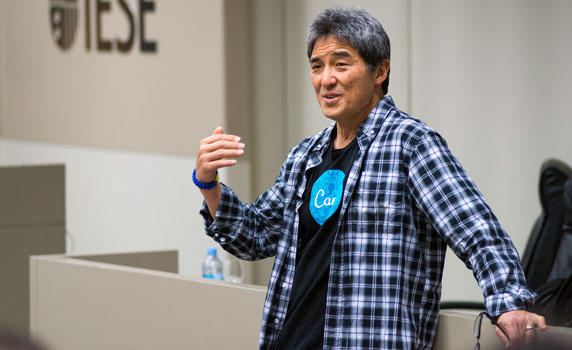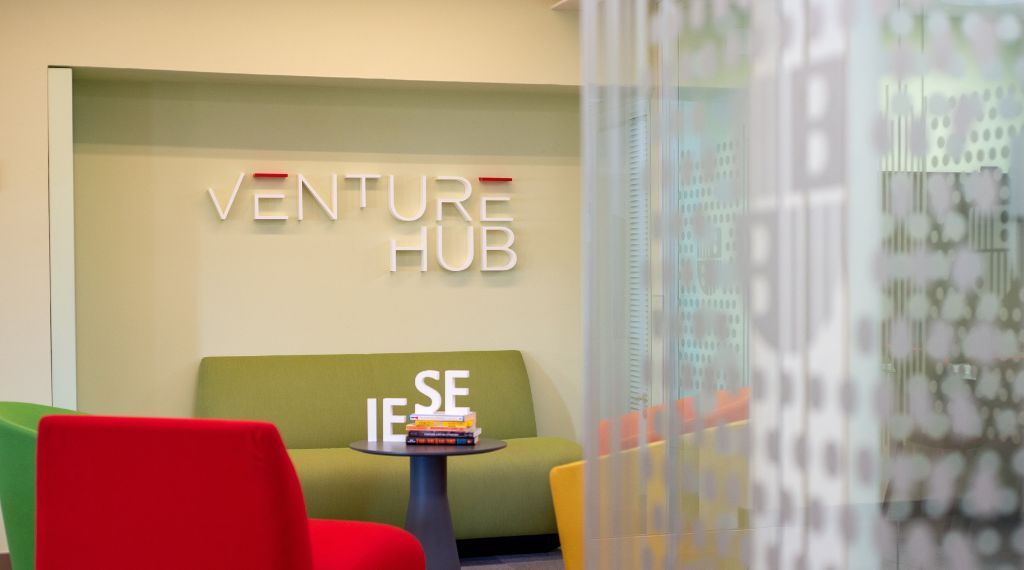Stories
Guy Kawasaki: Forget the Plan, it’s all About the Prototype
Former Apple “evangelist” talks about entrepreneurship
November 14, 2014

IESE welcomed celebrated entrepreneur, venture capitalist, author and social media maven, Guy Kawasaki, to the Barcelona campus for an extraordinary session with MBAs last night. A capacity audience had the chance to put their questions directly to the former chief “evangelist” of Apple, who shared his personal view on entrepreneurship in the digital age, and advice for anyone thinking of starting up. The session ranged over pitching to investors, developing prototypes, how technology is leveling barriers to entry in entrepreneurship, and what Kawasaki describes as the importance of “catalyzing fantasy.”
Infinite Monkeys
Free access to new tools and resources and social media, says Kawasaki, are making it easier than ever before to start companies. “The barriers are lower now, which is good because it’s cheaper and more straightforward to start up. But it’s bad, because everyone is doing it now.” In an increasingly competitive startup landscape, with “infinite monkeys,” the number one priority, says Kawasaki, is to have something to demo to potential investors.
It’s all About the Prototype
Technology and innovation have changed the business landscape, he says, making it practically impossible to create a meaningful business plan. “You can’t forecast five years into the future. What you forecast for this year is already late.” The key, he insists, is to build your prototype. And technology has also made this easier than ever before. “It’s not so much about the business plan, it’s about demonstrating your idea. Forget about the excel sheet or the power point – if you don’t have the prototype, you won’t sell the idea. And if you get the prototype right… you may never even have to pitch.”
Catalyze the Fantasy
As and when the time does come to pitch an idea to investors, Kawasaki has some solid tips for aspiring entrepreneurs. You have identified the product that you want to use, your value proposition is inherent, your prototype is ready to demo. So how do you prove there’s a market for your idea? “When you are in front of investors your pitch should kick off with evidence that you’ve bootstrapped and that your project is starting to take off with sign ups. The capital you need is for infrastructure to meet the demand. And this is where you catalyze the fantasy. You need to demo something so obvious that your investors will fantasize about how great it is, how people will use it and how much profit there will be to make from it.”
Build the Product You Want to Use
Kawasaki, like Steve Jobs, is not “much of a researcher.” No matter how much market research you do, he says, you cannot know for sure that your product will be a success. “It’s always going to be a roll of the dice. Did the Twitter founders really know there was a market for 140 character messages? There were already five or six other search engines out there when Google started. Who knew it was worth jumping onto?” Identifying opportunities is down to building the product that you would use yourself, he says. You need to want to use what you will invest your time building. “Nine out of every ten ideas will fail. And starting up is really hard. So you better love what you are doing.”
Success is Built on… Luck with Hard Work
Being first or best, says Kawasaki, does not necessarily guarantee success. “Sometimes it’s better to be a fast second, instead of the pioneer. If you’re not the first, you don’t have to be first. And being first doesn’t necessarily parse to being successful.” The secret to success, he says, if it exists at all, is about being able to work harder than the competition. “A lot of it is down to luck – and I know that being lucky is not a viable strategy. But in my experience luck comes to people who work hard. If I had to define why I’ve been successful, I’d say it ties to the fact that I can out-work others.”
“Steve-isms” and Lessons From Apple
Kawasaki worked with Apple twice, taking up a role as Apple fellow in the late 90s to “rejuvenate the Macintosh cult.” The lessons he learnt there weren’t always easy to process. Fear of not living up to Jobs’ expectations was a motivating force, he says. “The fear of Steve Jobs calling you ‘mediocre’ or worse is the most powerful motivation.” Jobs, he says, was a one-off, with a “different operating system to everyone else. People look at Steve Jobs and try to emulate him, but correlation doesn’t imply causation. Being arrogant or mean to others, or wearing New Balance doesn’t mean you’re Steve Jobs.” Apple would have done even better, he feels, had Jobs been “nicer” in his inter-personal relations. “I think the best thing any of us can aim for is to be competent. And to be nice with it.”
Democratizing Technology
Kawasaki is currently chief evangelist of Canva, an online graphic design tool. Evangelism in marketing, he explains, stems from a deep belief in the product. “It’s about putting the user first. The traditional sales person has his or her own interests at heart. But an evangelist wants to make others believe in the product or service as much as he or she does.” This shift in paradigm ties to the democratization of – or sharing accessibility to – technology; with industry innovation and digitization facilitating access to specialized, but user-friendly, tools. Difficult as trends are to classify, says Kawasaki, this shift is taking place around us, with plenty of successful models becoming household names – Airbnb, eBay and Bluebird among them. Social media and open source have changed the playing field, paving the way for the democratization of business. And this is set to continue, he says. “Social media is the best thing that has ever happened to brands. And it is the future of marketing.”


